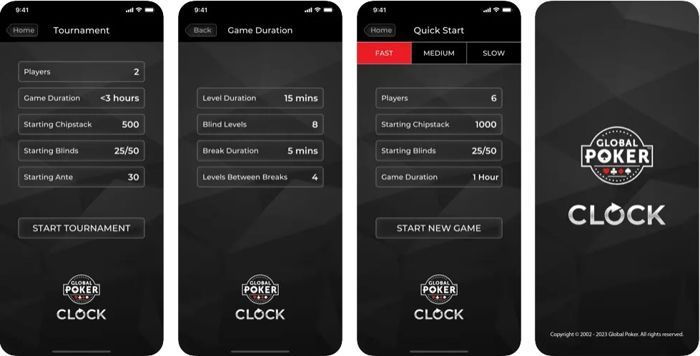Betting Structure, Blinds and Rules for your Poker Home Game

Poker home games are great ways to have fun with your family and friends. BUT, and it's a big but, getting the betting and blind structures right is crucial in ensuring the game runs smoothly and isn't too long or short. So, here's your complete guide from PokerNews on the betting structure, blinds and rules of your poker home game.
What Betting Structure Should You Use at Your Poker Home Game?
Choosing the right betting structure is pivotal for the dynamics of the game, and whether you play PLO, Holdem or any other variant, it's important to get it right. Our PokerNews guide is here to help you start the perfect structured game in your very own home.
Betting Structures at Your Home Game
We know the betting structure in a home poker game significantly influences gameplay dynamics. Fixed limit sets strict bet sizes, fostering a methodical approach. Pot limit allows more aggressive betting while capping the maximum wager. No limit, with its unrestricted betting, invites bold maneuvers and high-stakes thrills.
Choosing the structure aligning with your group's preferences dictates the game's pace, risk-taking, and strategic depth. Fixed limit suits a measured approach, pot limit adds excitement without excessive risk, and no limit fuels intense competition. Each structure crafts a distinct ambiance, shaping the game's intensity and style to match your home game's desired atmosphere.
What Blind Structure Should You Use at Your Poker Home Game?

Crafting the ideal blind structure lays the foundation for a captivating poker home game. The blinds dictate the pace and strategic depth of each hand.
Blind Structures at Your Home Game
Blind structures wield a profound influence on a poker home game's rhythm and tactics. A steep, rapid increase in blinds fuels aggressive play and quicker resolutions, perfect for fast-paced, intense sessions. Conversely, a slower increment allows for methodical, strategic maneuvers, ideal for a more relaxed, thoughtful game. Balancing the blind increments against the desired game duration and players' skill levels is crucial. Aggressive structures heighten tension and risk, while slower ones offer deeper strategic exploration. Tailoring the blind structure to match the group's dynamics and preferences ensures an enjoyable and engaging poker experience during your home game.
Blind Structure to Use for a Quick Poker Home Game (1-2 Hours)
For a 1-2 hour poker home game, consider a blind structure that doubles the blinds every 10-15 minutes. Start with blinds at 25/50 and increase them rapidly to 100/200, then 200/400, maintaining the pace for an intense yet manageable short-duration game.
Blind Structure to Use for a Mid-Length Poker Home Game (2-4 Hours)
For a 2-4 hour poker home game, a balanced blind structure can sustain engagement without rushing decisions. Begin with 25/50 blinds, gradually doubling every 20-30 minutes—progress to 50/100, 100/200, and beyond. This structure maintains strategy depth while ensuring an engaging, mid-length gaming experience.
Blind Structure to Use for a Long Poker Home Game (4+ Hours)
In a marathon 4+ hour poker home game, a slower blind progression preserves strategic depth and endurance. Start with 25/50 blinds, increasing every 30-45 minutes, moving through 50/100, 75/150, and beyond. This gradual rise maintains a thoughtful game pace, allowing for extended play without sacrificing depth or engagement.
A great FREE tool to help you setup your home game is Global Poker's Free Tournament Clock.

The Global Poker Clock app is free and the perfect poker management tool. Jump straight to the Quick Start, use one of our default settings to get started right away, and let it keep track of the current and upcoming blinds while you concentrate on beating the competition! If the default settings don't work for you, change them to your liking! Need even more customisation? Switch to Tournament Mode, where you can further customise the blinds and configure breaks for your game.
Additional Poker Home Games Reading...
- The Best Poker Cards for your Poker Home Game
- Best Poker Tables for your Home Game
- The Best Poker Variants to Play at Poker Home Games
- How to Setup the Table for your Poker Home Game
- How to Shuffle and Deal in a Poker Home Game
- Best Poker Chips set for Home Games
- Poker Home Games Strategy – How To Win
- The Best Snacks, Foods and Drinks for your Poker Home Game
- Top 5 Best Poker Gadgets you NEED for you next Poker Home Game
- How to Play Strip Poker
What Rules Should You Use at Your Poker Home Game?
Establishing clear and agreed-upon rules is pivotal for a smooth poker home game. Rule variations on actions like betting, hand rankings, and showdown procedures set the framework for fair and enjoyable gameplay. Here are some standard rules you should abide by, and some unique ones to make your game more interesting.

Standard Rules at Your Home Game
Implementing standard rules as the foundation of a home poker game ensures fairness, clarity, and a cohesive gaming experience. Key rules include a standardized deck of 52 cards, consistent hand rankings (from high card to royal flush), and clear betting actions (check, bet, raise, call, fold).
Proper handling of chips, ensuring they remain visible and easily countable, avoids confusion during bets and pot calculations. Enforcing table etiquette, like acting in turn and avoiding string bets, maintains order and fairness among players.
Moreover, defining rules for showdowns prevents disputes. Players must reveal their hands accurately to determine the winner, avoiding misinterpretations or disagreements.
Implementing a consistent set of rules regarding player behavior is crucial. Defining penalties for actions like collusion or chip dumping maintains game integrity and discourages unfair practices. Encouraging a respectful environment where players avoid discussing live hands or distracting opponents during play fosters a positive gaming atmosphere.
Additionally, clarifying rules around misdeals, such as exposed cards or premature dealing, maintains the integrity of each hand. Handling irregularities consistently, like identifying and rectifying errors promptly, ensures a smooth gaming experience.
Overall, adhering to standard poker rules establishes a fair and enjoyable environment for all players, minimizing confusion, disputes, and misunderstandings during the game.
Fun Rules to Introduce at Your Home Game
Adding a touch of creativity with fun rules can elevate the excitement in your poker home game. Consider these unconventional yet entertaining twists to infuse a unique charm into your play.
Bored of standard game? Let this PokerNews guide spice up the poker game with some unconventional rules!
Wild Card Roulette
Rule Description: Designate a specific card in the deck as a "wild card" for each round. This card, once revealed, becomes a wildcard, taking the value of any card the player chooses.
Fun Factor: Introducing a wild card adds an unpredictable element to the game, allowing players to turn a low-value card into a game-changing powerhouse. It adds excitement and strategic depth, as players need to decide the optimal moment to utilize this advantage.
Community Challenge
Rule Description: Designate a community challenge (e.g., everyone must imitate an accent, speak in rhymes, or wear a prop) for a set duration. Players who fail to meet the challenge pay a small penalty into the pot.
Fun Factor: Injecting humor and camaraderie, this rule encourages a lighthearted atmosphere. It creates memorable moments and fosters interaction among players, offering a delightful break from the usual intensity of the game.
Blindfolded Bluffing
Rule Description: Allow players, once per game, to make a blindfolded bet (placing a bet without seeing their cards) during a specific betting round.
Fun Factor: This rule introduces an element of daring and psychology. It's a high-risk, high-reward scenario, forcing players to rely on intuition, bluffing skills, and their knowledge of opponents' tendencies. It adds suspense and intrigue, creating unforgettable moments during the game.
These rules not only infuse entertainment but also encourage interaction and creativity among players, elevating the overall enjoyment of the poker home game.
Here's everything you need to host your own poker game!
| Poker Product | Necessity | Our Choice On Amazon |
|---|---|---|
| Poker Chip Set | Must Have A♦ | Buy Now |
| 2 x Proper Playing Cards | Must Have A♠ | Buy Now |
| Poker Table Felt | Must Have A♣ | Buy Now |
| Pro Poker Table | Nice to have K♥ | Buy Now |
| Funny Sunglasses | Just for Fun Q♦ | Buy Now |
| Poker Whiskey Glasses | Just for Fun Q♠ | Buy Now |
| I don't fold T-shirt | Just for Fun Q♣ | Buy Now |
| Poker Rap Star Chain | For Ballers J♥ | Buy Now |
Betting Structure, Blinds and Rules FAQs
What are the Best Blinds for Poker Home Game
For casual or beginner-friendly games, start with lower blinds like 25/50 or 50/100 to allow players to ease into the game.
Adjust blinds according to the duration you want. For shorter games, consider faster blind increments (e.g., every 10-15 minutes). For longer games, extend the time between blind increases.
What is a Good Blind Structure for a Poker Tournament?
A common tournament structure involves starting with smaller blinds (e.g., 25/50 or 50/100) and gradually increasing them over time, with longer intervals between increases compared to a cash game.
Any advice on Setting Up Poker Blinds in a home game?
- Determine the starting blind amounts based on the comfort level and experience of your players.
- Use a timer or designated player to manage blind increases at regular intervals.
- Rotate the dealer button clockwise after each hand, which determines the order of dealing and blinds.
What are the best Rules for Poker Home Games?
Implement standard rules for hand rankings, betting actions (check, bet, raise, call, fold), handling chips, and resolving showdowns.
Define specific house rules regarding player behavior, penalties for misconduct, and guidelines for handling misdeals or irregularities.
What is a good checklist for Setting Up a Poker Game at Home?
- Gather necessary equipment: standard deck of cards, poker chips, and a suitable table.
- Decide on the game variant (Texas Hold'em, Omaha, etc.), blind structure, and house rules.
- Assign dealer responsibilities or use a rotating dealer button.
- Ensure a comfortable playing environment with ample seating and proper lighting.
Who Acts First in Poker?
In most poker variants, the player to the left of the dealer acts first after the initial deal. The order of play proceeds clockwise around the table.
Who Bets First in Poker?
In betting rounds after the initial deal, the player closest to the left of the dealer usually bets first. The order continues clockwise.
